Did you ever imagine you could pull music from thin air?
From drums, rims, kicks, to full-on 88-key classical piano, in the world of audio synthesizers, anything is possible!
What is synthesis, and how is it possible that a single device could end up replicating so many sounds?
Let’s find out!
What Is Synthesis?
Audio synthesis is a technology of producing sounds from scratch, usually through voltage manipulation.
It could be used to replicate real-life instruments or just about any sound effect you would need to enhance a music track both on stage and studio.
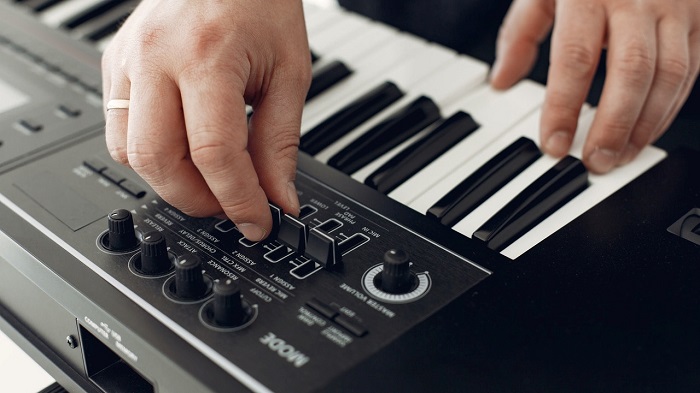
History of Audio Synthesis
It’s often told that the very first synthesizer was the Radio Corporation of America’s Mark I back in 1952.
It took Harry Olson and Herbert Belar the better part of a year to get it done, and it was so huge that it took up a full room to set up.
In a sense, it was an analog computer with applications in music.
By 1957, they were ready to release their second synth, Mark II, which was also nicknamed Victor. The second edition introduced a high and low-pass filter with several effects like glissando, vibrato, and resonance.
However, if you take a look back in early 1920, we’ll see a Soviet innovation in the first electronic instrument, called the Theremin by León Theremin.
The Theremin wasn’t a true synth in the sense, but it still astonished minds by how the music would stream out without continuous human contact with the machine.
You might even be interested in seeing the Theremin in action with a dazzling performance of Harold Arlen’s Over the Rainbow!
Although the first attempts were way less practical than what we have today, it was all a nudge in the right direction.
Soon, the music industry was booming with both analog and digital synthesizers!
Analog vs. Digital: The Two Types of Synthesizers
After the RCA’s Mark series, several companies jumped on the chance to create their own versions of the huge machine.
This includes Moog Music, Korg, Roland, Arturia, Yamaha, Novation, Nord, Sequential, and many others.
If you look at all these brands, you can fit their productions into one of two synthesizer main categories:
Analog Synthesizer

Analog synthesizers first started coming to the music world in the 1960s in the hands of Robert Moog.
Once Musical Instrument Digital Interfaces (MIDI) became a standard tool for producers, analog synths became even more and more common.
The analog synthesizer is also called the Voltage-Controlled Oscillator or the VCOs because it relies on the interaction between electric circuits to function.
Now, you can even see virtual versions of the analog synth in Visual Studio Technology or VST plug-ins.
All in all, the analogs are more authentic sounding with a wider range for customization than the digital synth. Plus, their learning curve is easier and less challenging.
Digital Synthesizers
Digital synthesizers were created around the 1970s, and they were designed to be a step up from their analog counterparts.
Several leaps in software technology have helped spread the digital synths deeper into the heart of the music industry.
Take, for instance, how Steinberg’s DAW Cubase allowed the producers to connect virtual instruments to their computers through MIDIs.
Yet, analogs are still famous for their quality and authenticity. That’s because Digital Signal Processing (DSP) doesn’t fully compensate for the analog synth’s electrical circuits.
That’s to say that the digital synth is, in its core, a computer in the shape of a keyboard. Meanwhile, analogs have more in common with true instruments.
Basic Sound Waveforms Used in Audio Synthesis
Before we dig into all the technical jargon, let’s see what’s in a note anyway?
The way we hear sound is when waves are carried through the air to hit our ears, and thanks to highly sensitive auditory responses, we get to sense the slightest shift in air pressure.
Although there are over 20 different types of synthesizers, the base concept still relies on four basic waveforms.
If you’ve ever worked closely with oscillators, like the LFO, you properly know these waveforms as the sine, sawtooth, triangle, and square.
Each waveform helps shape a certain aspect of music, and knowing how to identify them on an oscilloscope will save you a lot of hassle.
Sine Waves
You can use the sinusoidal wave to create the deep sub-bass notes on the lower-end audio spectrum.
For instance, you can spot the sine or the sinusoidal waves in the low-end portion. That’s because they create sounds that are on the soft side with their round peaks.
They are the most basic of the four waveforms, and layering them in different ways can produce the other shapes.
Triangle Waves
Meanwhile, triangle waves add a little sharpness and are responsible for odd harmonics that lose their volume very quickly.
They’re almost halfway between a sine and a square, but they keep the sound characteristic mostly basic.
Triangles have several applications in audio synthesis. Yet, when I think of a triangle wave, I always end up thinking of a tapering flute, for some reason.
Square Waves
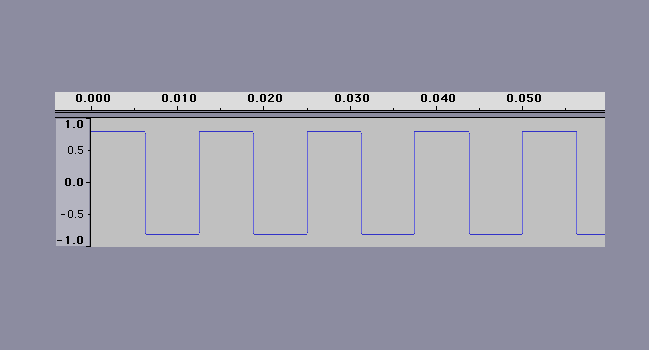
Squares resemble triangle waves. You could even get a square wave sound like a triangle one if you use a traditional low-pass filter.
However, you can tell a square wave on an oscillator by how full and boxy it looks. Plus, they often sound hollow and nasal.
In audio synthesis, you’ll often see square pulses being used to replicate wind instruments like the clarinet.
Saw Waves
Another wave with a full graph is the saw, but it has several grooves that decrease in size as the wave comes to a close.
You create a saw wave by merging a bunch of sines, which is the basis of the additive synthesis method, but we’ll get to that later!
Sawtooths also have double the amount of harmonics present in a square pulse, and they’re known for being buzzy. You can see the saw waves used to generate strong bass.
Pulse Waves
Quite often, all four types come together to create a pulse wave. The pulse’s harmonics are a balance of all its components.
However, the word “pulsating” in audio springs up the image of a square wave in mind. That’s because squares close off neatly, giving the implication of a pulsating note.
You can see a common application for this pulsation in pulse-width modulation seen in older synth models.
How Does Analog Audio Synthesis Work?
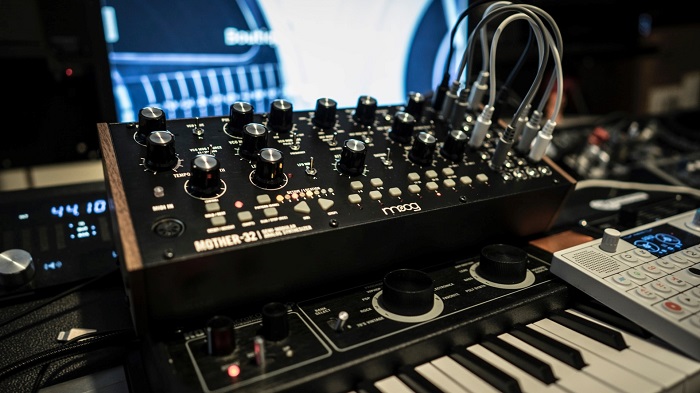
Synthesizers contain a generator portion and a resonator portion. The generator portion is where things get technical.
While a digital synthesizer depends on a numerically controlled keyboard that’s hooked up to a computer, the analog synthesizer is all about voltage manipulation.
The voltage signal is triggered by an input controller to induce an oscillator to produce a waveform. Then the wave is filtered, amplified, and modulated.
Let’s see all that in more detail:
1. User Input into the Synthesizer
User input is the way you can initiate a signal on the synth. There are several ways you can input data into an analog synthesizer.
A common controller interface uses keyboards, knobs, and sliders, all of which you can see in devices like the Yamaha DX7.
But you can also get a synth that connects to a MIDI guitar setup or even something that syncs to an iOS app!
2. Sound Generation (Synthesis)
With analog synths, voltage manipulation is where the actual sound generation begins after you input a signal, hence why the device is called a Voltage-Controlled device.
This voltage signal then flows into the oscillator, which in turn, starts its waves with a specific pitch and frequency depending on the original signal.
Keep in mind that the same wave characteristics, including frequency, amplitude, and velocity, apply to the oscillator’s waveform.
3. Synthesizer Filtration
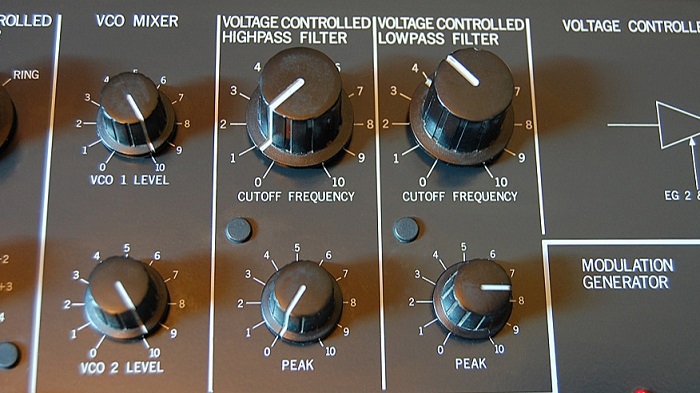
Once the oscillator produces the waveform that corresponds to the input signal, it then has to go through an audio filter.
Much like an EQ effect, you can use the synthesizer to filter out certain frequencies from the audio spectrum.
The most common type of filter you’ll come across is a low-pass. However, some filters will have both a low-pass and a high-pass filter working in series since parallel routing is more expensive.
Depending on the number of poles in the filter, you get varying degrees of noise reduction. For instance, if you have two poles, you get a total attenuation of 12db per octave.
It might sound trivial, but the filter’s impact on the shape and quality of synthesized tones is immense. You can see the extent of this effect by shifting the cutoff point and comparing.
Keep in mind that filters don’t abruptly eliminate sounds at the cutoff point. Instead, it creates a sloping figure till you reach the desired result.
4. Synthesizer Amplifying and Effect Merging
Once the waveform is filtered out, you should end up with a crisp clean note that’s ready for amplification and envelope effects.
A synth’s amplifier consists of a series of envelope controls working together to spot nuances in the wave’s volume levels.
This amplification step helps create a consistently loud note without shaky spots along with the wave’s lifespan.
5. Synthesizer Modulation

Modulation helps give life and imply movement to the musical notes, and it revolves around LFO principles.
Instead of being an automated step, the producer gets to choose between effects like tremolo by shifting the volume in an oscillating pattern.
It’s also possible to induce vibrato by shifting the pitch periodically after a small delay to replicate a real-life vibrato effect.
What are the Methods of Audio Synthesis?
There are well over 20 types and sub-types of audio synthesizing methods. Some are more common than the others, but they’re all pretty interesting, nevertheless.
Let’s take a look at some of the methods you’re most likely to come across:
1. Subtractive Synthesis
Subtractive synthesizers essentially overproduce their waveform initially and take out what’s unnecessary later on during the filtration step.
I once read how Roland described the process in terms of “sculpting” out the desired note from a thick waveform, and the analogy stuck with me.
While this method of synthesizing doesn’t cater all that much to authenticity and accuracy, it still offers a wide range of customization options to work with.
You can find subtractive methods in synths like the Moog One, Steinberg Retrologue 2, Roland MKS-50, Native Instruments Reaktor, U-HE Diva, and TAL NoiseMaker.
2. Additive Synthesis
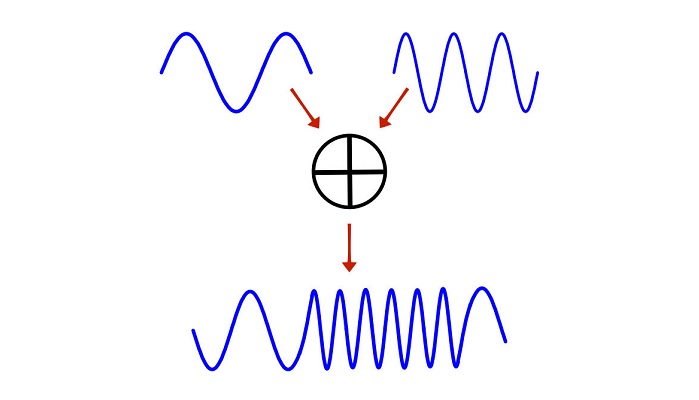
Remember how we covered that basic sine waves can be bundled to shape other complex waveforms?
Additive synthesizers blend in sinusoidal waves to create entirely new harmonics, essentially from scratch.
This method doesn’t require “sculpting” like subtractive synthesis. Yet, you still need a filter in your additive synth to keep the noise down, if nothing else.
Additive synthesis is most common in digital models. However, you might want to check out Alchemy, Kawai’s K5, or VirSyn Cube 2 for a start.
3. Frequency Modulator (FM) Synthesis
In a typical FM synth, you’ll find two oscillators: a modulator and a sine wave carrier. Together, they create new harmonics or sidebands by bending the frequency range.
It’s very similar to additive synths, but producers usually find that FM synthesis works best for replicating the bass attack of electric pianos and bells.
Some of the synthesizers that use frequency modulation systems are the New England Digital Corporation’s Synclavier I.
You might also find virtual plug-ins that are capable of frequency modulation, like Apple’s Retro Synth for Logic Pro.
4. Amplitude Modulation (AM) Synthesis

AM modulation works in a way that’s similar to FM, except it targets the volume instead of frequency to create new harmonics using a sine wave carrier.
Did you know that amplitude modulation can also be used in the radio industry for sound transmission in the frequency range of 535-1705 Hz?
However, FM synths are often favored over AM ones, both in audio synthesis and radio transmission.
It’s hard to find a synth that relies solely on AM, but you can find it as an added feature in synths like in Tone 2’s Gladiator.
5. Wavetable Synthesis
Wavetable is a little different from traditional analog synthesis. Although they share the same core components, wavetables ditch the concept of voltage manipulation.
Instead, this retro-style synth relies on a series of waveform samples that could be separated and reshaped.
If you do a lot of pad work, you’ll find that wavetable synthesis gives droning sounds a bit of an edge.
A few common wavetable synths are the PPG Wave, Waldorf’s Nave, Kilohearts’ Phase Plant, Xfer’s Serum, Spectrasonics’ Omnisphere, Tone 2’s Icarus, and Native Instruments’ Massive X.
6. Granular Synthesis

A granular synth works by slicing up samples into minuscule time frames between the 100th and 10th of a second to create a “fine grain” that could be reshaped to any note sequence.
However, this method requires an extra step to smooth all the grain together. Otherwise, the sound could end up glitchy and clicky.
Granular synthesis went from devices like the 1970’s Xenakis and Curtis Roads to be a staple in the modern industry.
A few common granular synths are Portal, The Mangel, Palindrome, PolyGAS, Ribs, and Fruity Granulizer. Even with the additive synth, Alchemy is capable of granular synthesis.
7. Phase Distortion (PD) Synthesis
Phase distortion is often referred to as phase modulation or PM synthesis. In a sense, it’s a lot similar to the FM method, but it offers a wider range of harmonic overtones.
In fact, some FM synths follow more of a phase distortion method, like the Yamaha DX7. Other synths like the ZynAddSubFX can synthesize music both ways.
The main difference here is that the FM creates new waveforms that are proportional to the voltage only, while PM waveforms depend on both the voltage and the frequency input.
Just as the name implies, these methods are ideal for creating phasic effects and operator tones.
8. Vector Synthesis
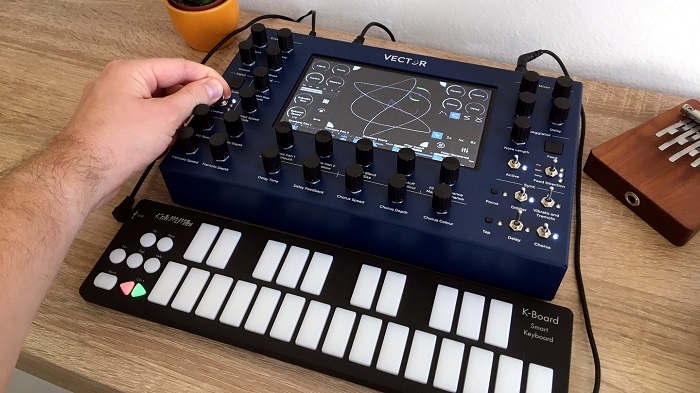
In vector synthesis, the sound is generated by crossfading a bundle of single-cycle sources (usually four) to create the impression of an entirely new waveform on the grid center.
That’s because each one of those four sources takes over a corner on the grid. Moving across this grid, you get distinct sounds.
Many people find the appeal of vector synthesis in using a joystick to navigate along the X and Y-axis.
A few well-known vector synths out there are the Yamaha TG33, Yamaha SY22, Sequential Circuits Prophet, and UVI Vector Pro.
Tips on Mastering Audio Synthesis
Here are some tips and tricks that can make your life easier when you synthesize music:
Don’t Shy Away from Using Samples and Presets
More often than not, you’ll come across people who take pride in never using pre-set edits and doing every note touch-up themselves.
However, there’s absolutely no shame in using samples and pre-set notes to get you where you need to be. Remember that it’s much better to work smart, not hard.
Avoid Boxing Yourself With One Synth
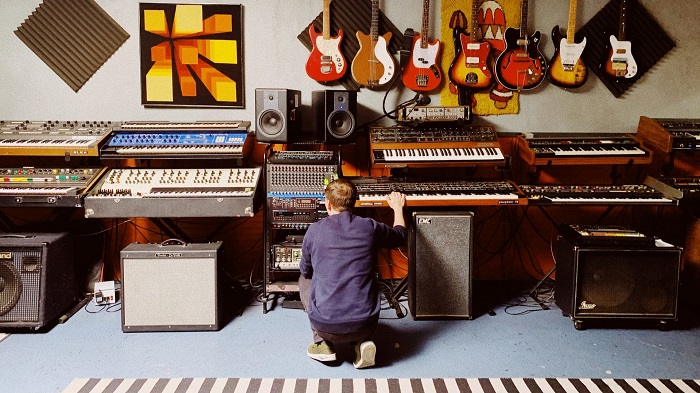
I get that using a single synth interface every time might be comfortable, but it’s like putting a leash on your capabilities.
Take your time to explore other options. There are way more worthwhile synths than we can even list in a single post, but you might want to start with subtractive ones first.
Preserve Your Progress As You Go
Do you know how you get to a certain sweet spot and device to push further anyway in hopes of getting a better note?
Well, often, you’ll end up wondering how to get back. That’s when you’ll wish you had recorded your progress earlier. Oh, how I wish someone gave me this advice when I was starting.
Don’t Get Lost in the Process
I always recommend experimenting and playing around with your music workshop. However, I also see the point in meeting deadlines.
Set a certain limit, do your best in the given period, and then drop it and move to the next task along the line. It’ll save you a ton of headaches.
FAQs
Let’s move on and check out some of the frequently asked questions when it comes to audio synthesis:
Q: What is a synth filter cutoff point?
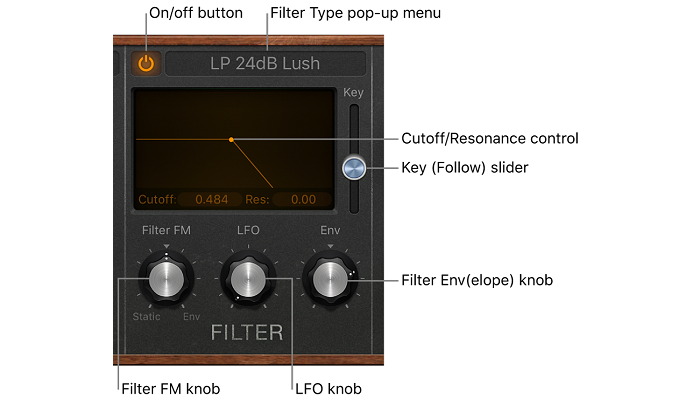
A: The cutoff point (also called cut) is the point at which the filter begins to eliminate the selected range of frequencies.
For instance, you can use a low-pass filter to remove any note that falls lower than 1000 Hz. In this case, your cutoff point is 1000 Hz.
Q: Is an amplifier necessary for a synth?
A: You don’t necessarily need an amplifier if you’ll be working in a closed studio environment, and you’ll be mainly practicing with some notes.
However, I like using the amplifier to make sure my notes are loud, crisp, and clean regardless of where I’m using the synth.
Q: What is granular synthesis reverb?
A: Granular reverb is a regular delay that you add to any sound. However, it lacks a bit of realism.
You can simulate a reverb-like effect by tweaking the spray parameters to scatter the grain just right. You also use both the allpass and the comb filter to get a similar result.
Q: Do you need to play the piano to use a synth?
A: You don’t have to be a piano wizard to synthesize sounds. You just need to know your basics and know your way around the keyboard.
Of course, you also need to be familiar with music production basics, from amplitude, pitch, and samples to EQ and MIDI interfaces.
Q: Can you synthesize any sound?

A: While synthesizers are very handy, they still have their limits, and there’s only so much you can do on the machine.
As a general rule, you need to keep your expectations a tad bit low when it comes to hyper-realistic sounds and complex notes.
Q: Can you hook up headphones to a music synthesizer?
A: Yes, it’s possible to use a synthesizer while wearing headphones as long as you’re using the proper jack or adapter.
If you’re going to buy a synthesizer that doesn’t have a built-in speaker, I’d recommend confirming that the jack is a common size, like ¼ inch or so.







